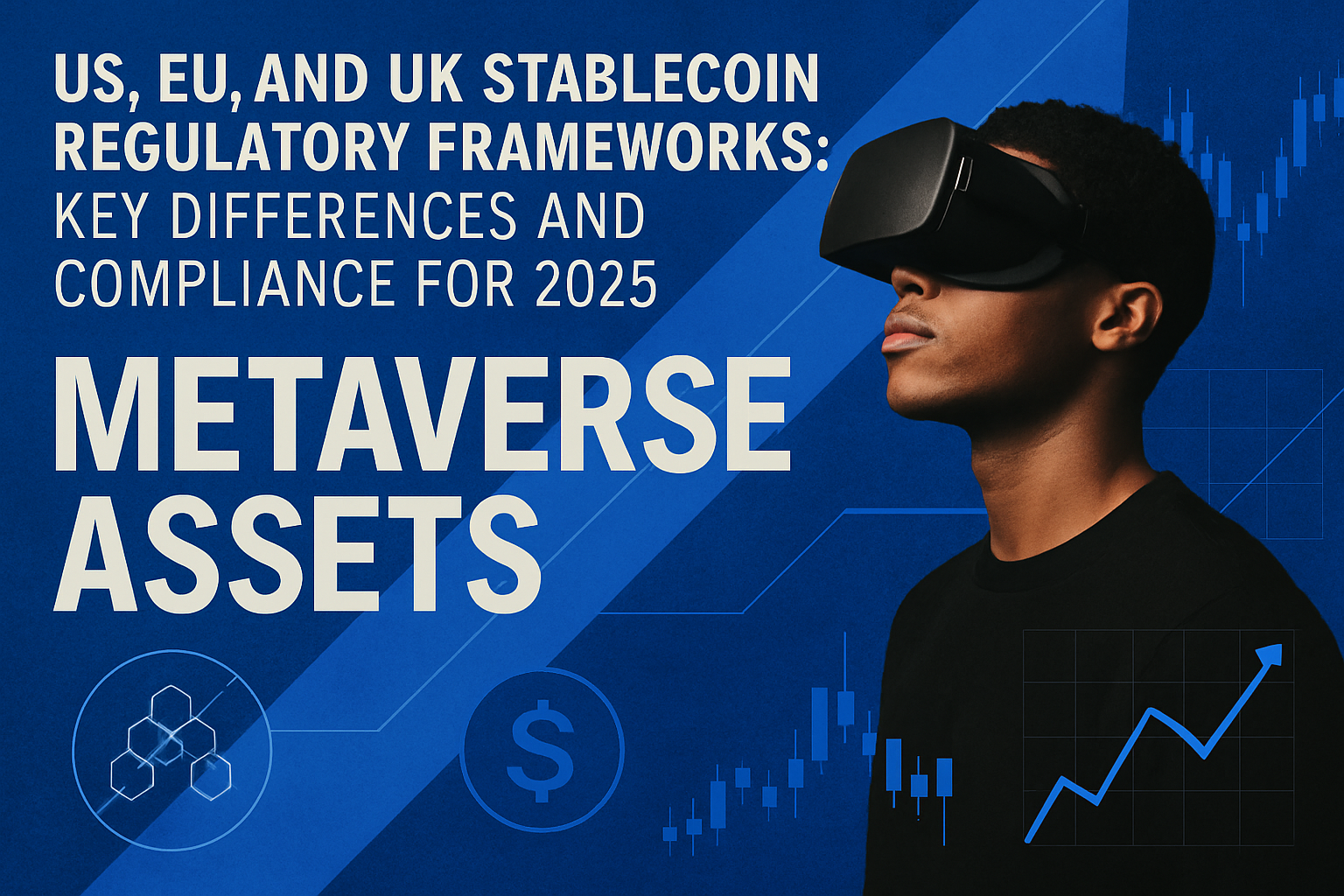
Stablecoin regulation is rapidly evolving, with the US, EU, and UK each taking distinctive approaches as we head into 2025. The regulatory frameworks now in force are not merely technical updates; they fundamentally reshape how stablecoins can be issued, managed, and used across borders. For legal professionals and crypto businesses alike, understanding these differences is crucial for effective compliance and cross-jurisdictional operations.
![]()
US Stablecoin Laws 2025: The GENIUS Act’s Federal Framework
The United States made a decisive move in July 2025 with the passage of the Guiding and Establishing National Innovation for U. S. Stablecoins Act (GENIUS Act). This law represents a watershed moment for digital asset regulation in America. Under GENIUS:
- 1: 1 Reserve Backing: All permitted payment stablecoins must be fully backed by US dollars or other low-risk assets.
- Licensing: Issuers must obtain a federal license, facing rigorous oversight from federal agencies.
- Transparency: Regular audits and public disclosures are mandated to ensure consumer protection.
- Securities Clarity: Compliant stablecoins are explicitly not classified as securities, this removes a major legal gray area for issuers and investors.
This framework gives much-needed clarity to both US-based issuers and foreign firms seeking access to American markets. However, operating in the US now requires significant investment in legal infrastructure and ongoing compliance costs. For more on how these changes impact market participants, see our detailed breakdown of the GENIUS Act.
EU MiCA Stablecoin Rules: Strict Uniformity Across Member States
The European Union’s Markets in Crypto-Assets Regulation (MiCA), which became fully operational in December 2024, sets a single regulatory standard across all 27 member states. MiCA’s approach features several unique aspects:
- Differentiation: MiCA distinguishes between e-money tokens (EMTs) and asset-referenced tokens (ARTs), each with specific compliance paths.
- No Interest Allowed: Offering interest on stablecoins is strictly prohibited, an important difference from both the US and UK regimes.
- Tough Reserve Rules: Robust reserve backing is mandatory, including regular audits and on-demand redemption at par value.
- No Algorithmic Stablecoins: These are outright banned under MiCA due to risk concerns.
- No Non-Euro Stablecoins for Payments: Usage of non-euro denominated stablecoins for payments within the EU is significantly restricted.
This has already led major exchanges to delist popular tokens such as Tether (USDT) within Europe, a clear sign that MiCA’s rules have teeth. For an in-depth comparison of US vs EU frameworks, visit our side-by-side analysis.
| United States (GENIUS Act) | European Union (MiCA) | |
|---|---|---|
| 🏦 Reserve Requirement | $1: 1 backing by USD or low-risk assets | Robust reserves; regular audits |
| 🛡️ License Needed? | Federal license required | Email Money Institution or Crypto-Asset Issuer authorization |
| ❌ Interest Permitted? | No explicit ban | Banned |
| 💶 Non-Native Currency Use? | No restriction | Banned for payments if not euro-denominated |
| 🤖 Algorithmic Stablecoins? | No explicit ban yet | Banned |
The UK Approach: Gradual Integration with Banking Safeguards
The United Kingdom’s regulatory journey has been more cautious but is now gaining momentum under the Financial Services and Markets Act 2023. The Financial Conduct Authority (FCA) has outlined new rules focusing on fiat-backed stablecoins first before expanding to cover broader crypto-assets. Key features include:
- A requirement that reserves be held with trusted institutions like the Bank of England, ensuring robust consumer protection.
- A bespoke licensing regime under FCA supervision tailored specifically for stablecoin issuers.
- An emphasis on integrating stablecoins into existing payment systems while maintaining banking-grade oversight for systemic players.
This phased approach means that while some aspects remain less defined than their US or EU counterparts, clarity is increasing as new consultations close and final rules are published. For an overview of how compliance strategies differ by jurisdiction, see our resource on compliance as code across regions.
For stablecoin issuers and service providers, these regulatory divergences are more than theoretical, they directly impact business models, product design, and cross-border operations. The result is a patchwork of compliance obligations that can be both an operational hurdle and a competitive differentiator for those who navigate them effectively.
Cross-Border Challenges: Licensing, Payments, and Regulatory Arbitrage
Operating across the US, EU, and UK means confronting a series of practical challenges. Licensing remains a primary barrier: a stablecoin issuer must often secure multiple authorizations, such as a federal license in the US, EMI status in the EU, and FCA approval in the UK. Each regime has its own definition of what constitutes permissible reserves and which assets are considered “low-risk. ” This means that even a fully compliant stablecoin in one region may not be eligible for listing or use in another.
The EU’s ban on non-euro stablecoins for payments is already shaping market behavior. For example, major exchanges have begun delisting USDT within the bloc to avoid regulatory penalties. Meanwhile, the US’s focus on dollar-backing and the UK’s emphasis on integration with traditional banking systems create different compliance priorities for international projects.
Cross-Border Licensing Requirements and Payment Restrictions for Stablecoins (US, EU, UK, 2025)
| Jurisdiction | Licensing Requirement for Issuers | Cross-Border Licensing/Recognition | Payment Restrictions | Interest on Stablecoins |
|---|---|---|---|---|
| United States (GENIUS Act) | Must obtain federal license as permitted payment stablecoin issuer | Foreign issuers may register under ‘comparability’ regime or establish US subsidiary | No explicit restriction on use of non-USD stablecoins in payments | Not specified |
| European Union (MiCA) | Must be authorized as EMI or Crypto-Asset Issuer | Passporting available across EU; non-EU issuers must obtain local authorization | Use of non-euro stablecoins in EU payments is restricted; algorithmic stablecoins banned | Offering interest on stablecoins is explicitly prohibited |
| United Kingdom (FSMA 2023) | Must be authorized by FCA under bespoke regime; reserves with Bank of England for systemic issuers | No formal passporting; recognition of foreign issuers under review; regime still evolving | No explicit restriction on use of non-GBP stablecoins in payments | Not specified |
Regulatory arbitrage, the practice of exploiting jurisdictional differences, remains a risk but is increasingly difficult as global coordination improves. The GENIUS Act’s comparability regime allows foreign issuers to register in the US if they meet equivalent standards, but this process is complex and subject to ongoing review. The EU’s MiCA framework similarly sets a high bar for equivalence from non-EU issuers.
Merchant Adoption and Compliance: What Businesses Need to Know Now
For merchants and payment processors considering stablecoin adoption in 2025, understanding these rules is not optional, it is essential risk management. Key considerations include:
- Due Diligence: Always verify that any stablecoin used or accepted is fully compliant with local reserve and licensing rules. Non-compliant tokens risk delisting or legal challenge.
- Transparency: Require regular proof of reserves and audit disclosures from issuers before integrating stablecoins into payment flows.
- Geofencing: Some platforms now restrict access to certain stablecoins based on user location to avoid breaching local laws, merchants must stay current on these restrictions.
- Ongoing Monitoring: Regulatory environments are evolving rapidly; continuous monitoring of updates from the FCA, SEC, and ESMA is vital.
Looking Ahead: Evolving Standards and Global Coordination
The landscape of stablecoin regulation comparison will continue to shift as policymakers respond to new risks and opportunities in digital finance. International coordination is improving but far from complete. The emergence of compliance-as-code solutions and blockchain analytics tools is helping issuers streamline reporting and adapt more quickly to regulatory changes, a trend explored further at our compliance technology guide.
Ultimately, success in 2025 and beyond will require not just technical innovation but also a deep understanding of legal obligations across every market where a stablecoin operates. Firms that invest early in strong compliance infrastructure will be best positioned to benefit from regulatory clarity, and to build trust with users and regulators alike.




